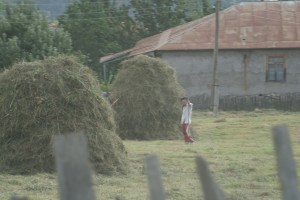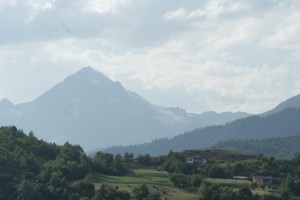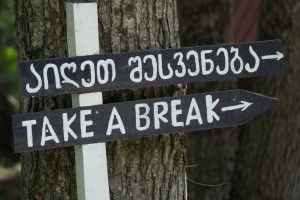I’d wanted to go to Svaneti for years – this far off, remote exotic corner of a far-off, remote exotic land. Now, with three kids in tow, I finally had my chance.
Originally, I had planned for us to go to Svaneti the way most backpackers do – take the night train from Tbilisi to Zugdidi, and then catch an early morning jeep up the mountain to Mestia in Svaneti. After a couple of days in Georgia, once I understood how the trains and shared taxis actually worked, I changed my mind, and this is why, heading out of Kutaisi at about 2pm, we were sitting quite comfortably in our own (hired) van with our own driver. Everything that I had read led me to believe that one had to have a 4×4 to negotiate the road up to Mestia. Yet Malchas, our driver, insisted that he had done his own homework, and that he had been assured that his Toyota van would be able to make the trip. I certainly wasn’t as confident as he was, but I agreed that we would go with him. I think he was really keen to go for a few reasons – most importantly, we’d be hiring his services for a few more days and secondly, he had never been to Svaneti himself, and was keen to go.
(In hindsight, despite some difficulties (more to come) this was a great way to travel – the Basque couple that we met in Sighnaghi later took the train to Zugdidi, and I have no doubt that Hilit and the kids would have simply refused to get onto that train, where “hard class” would have been a perfect description in so many ways).
We made it to Zugdidi quickly – It was sweltering hot, and we stayed just long enough to buy some drinks. Zugdidi is the main city of the Mingrelia district – the people speak a different language from the rest of Georgia, and this area was closest to the conflict regions of Abhkazia in the civil war in the early 1990’s. Apparently for years and years Zugdidi was home to a huge amount of refugees, but the city looked in decent shape to me. In fact, the whole region looked quite well to do. Large homes standing on large pieces of ground, and every home seemed to be growing something – wheat, fruit, corn, vines…you name it. These people seemed to realise that in their part of the world being self sufficient made a whole lot of sense.
Leaving Zugdidi, the road started climbing up and up and for the first 50km or so was in good shape. The scenery was incredible – we passed a huge dam, site of Georgia’s largest hydroelectricity source, but once past the dam the road sort of disintegrated. It was kind of paved, but the potholes, ruts, rocks and animals became worse and worse. The drive was spectacular – half the time we were driving along the edge of a cliff, with a huge river rushing beneath us, and the road edge was barely protected by a fence here or there and often by nothing at all. Signs were non existent. We passed some road works here and there, or sometimes just a piece of road building equipment , sitting on its own with workers in sight. Our travel time slowed dramatically to about 20km/hour. At one point we traveled 16km in one hour. It was clear that Malchas was starting to regret his (reckless?) decision to drive his van on this road. The road stretched around corners, bends, up passes, past villages, haystacks, people working in the field, and huge snow-capped mountains. At one point we began to pass road signs every kilometer showing the distance traveled from Zugdidi and the distance to go to Mestia, and each slow, painful kilometer we drove was like having a tooth pulled. I don’t know if this was someone’s idea of a joke or whether it was to stop drivers from going mad. From time to time we would pass by little shacks selling beer, drinks, cigarettes and cookies along the side of the road, in the absolute middle of nowhere! In lieu of fridges, beer and drinks were kept cold in the rivers!
The kids were fine through all this – hot, as Malchas had to turn off the a/c in order to find more power from the engine, but otherwise they were ok. Eventually, we arrived in Mestia.
Mestia is the main town of Svaneti – relatively prosperous, the road just out of town was being actively worked on, and the main square was being completely relaid. It is clear that the authorities have designated Mestia as a place for significant investment. It remains for now a tiny place – lots of pigs and chickens running on the streets, a few guesthouses, one hotel, one restaurant, one grocery store and tons of character – old houses, huge fortified towers, a river rushing wildly though the town. But it did have an ATM, clearly a new development following the publication of the most recent copy of the Lonely Planet guide to the region.
We found our guesthouse – initially I had booked us into Nino Ratiani’s place, the main backpacker guesthouse, but we had been advised that it would be more comfortable staying at the house of the (fairly elderly) Gabliani sisters – daughters of the most famous Svanetian mountain climber ever. One sister was the town English teacher and spoke excellent English. Their large rambling house near the river was a very spacious place – we were given two adjoining rooms, though we had to share the bathroom with another group of travellers. Unfortunately, the other guests (a German family with a teenager) were really unsociable and so our only regret was the lack of interesting and friendly people to chat to. I walked over to the other guesthouse and indeed, that appeared to be a far friendlier place, filled with backpackers of all ages. But they were full so we stayed where we were.
After an incredibly long day of travel (about 12 hours from Tbilisi) the kid were very happy to be out of the car – we went for a walk down to the river, walked to the grocery store, watched some kids playing soccer and enjoyed stretching our legs.
The Gablianis were friendly – they gave us a huge dinner and arranged a driver to take us up a mountain the following day.
PS: These days I help plan great trips for families. Click here for more info.



